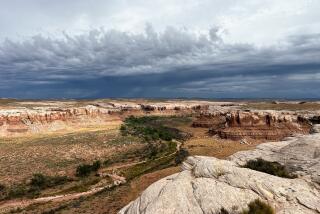Bush Hails Grand Canyon Clean-Air Pact : Pollution: Critics question whether the President had fully supported the plan, which aims to reduce haze linked to a nearby power plant.
GRAND CANYON, Ariz. — President Bush sought to stake his claim on a powerful domestic issue as he traveled here Wednesday to hail a historic agreement to cut air pollution in this scenic national landmark.
In his first stop on a campaign-style three-day trip through the West, Bush described the government-brokered accord between business and environmentalists as an example of a “common-sense approach” that he said should be a model for tackling other environmental problems.
“If we divide up like the Hatfields and the McCoys, we don’t solve anything worthwhile,” he said.
But critics questioned whether Bush had been a full supporter of the widely acclaimed plan.
“The Bush record on the environment is a fraud,” Sen. Albert Gore Jr. (D-Tenn.) charged. “The gap between his rhetoric and his record is deeper and wider than the Grand Canyon itself.”
Bush, wearing a Western shirt and speaking from a stage erected on the South Rim, was clearly eager to counter such attacks. “I just have to ask some of the critics out there--how’s this for the vision thing?”
The air pollution accord, made public last month, requires the Navajo Generating Station in nearby Page, Ariz., to reduce sulfur dioxide emissions by 90% before the end of the decade in an attempt to end the conditions that can leave the canyon blanketed in haze.
The deal was praised Wednesday by a wide range of interest groups. But officials of some environmental organizations pointed out that the Bush White House earlier this year called for only a 70% reduction.
Administration officials traveling with Bush said the White House now supports the stricter controls because negotiations between industry and environmental groups, coordinated by the Environmental Protection Agency, had found a way to make the deeper cuts less costly.
The plan is expected to impose additional costs of $89 million a year on the coal-burning power plant. For customers of the Los Angeles Department of Water and Power, which buys about 23% of the electricity generated by the plant, the additional cost is expected to be about 2% a year.
The pollution controls initially were to have taken effect in 1995, but under the compromise they will not begin until 1997. The Administration predicts that the cutbacks should improve visibility at the Grand Canyon only by 7% on the average winter day, causing some within the environmental community to contend that the plan does not go far enough.
Bush, in declining to respond to what he called “the extremes among the critics,” defended the plan as “one that honors our love of the environment and our commitment to growth.”
But a senior Administration official traveling with Bush conceded that the emission cuts are unlikely to have much effect during summer months, when smog blown from Los Angeles is the principal cause of the haze.
The effort by Bush to invite attention to what his spokesman called “the beautiful domestic agenda that’s all around us” later lost its intended focus when the President interrupted a hike deep within the canyon for an impromptu news conference about his announcement that he is prepared to send U.S. military aircraft to Iraq to escort U.N. inspection teams.
But he returned to domestic issues later in the day during a visit to Salt Lake City, Utah, where he called on Congress to increase funding for a program designed to reduce the rate of infant mortality in areas where its incidence is highest.
Bush will visit a freeway construction site in Los Angeles today to push for congressional action on a highway construction bill.
More to Read
Get the L.A. Times Politics newsletter
Deeply reported insights into legislation, politics and policy from Sacramento, Washington and beyond. In your inbox three times per week.
You may occasionally receive promotional content from the Los Angeles Times.










